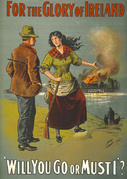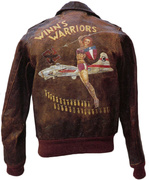
“Eat Less,” by Hendee, lithograph, 1918.
Earlier this month, while browsing the Library of Congress website for Armistice Day images, we came across this provocatively titled 1918 lithograph, created by an artist named A. Hendee and printed by Edwards & Deutsch of Chicago for the United States Food Administration. That agency was established in August of 1917 by the Food and Fuel Control Act, which was designed to, among other things, keep grain prices low so food would be more economical to distribute to the Allies in Europe. The act also restricted the use of grains in alcoholic beverages, making it a catalyst for the 18th Amendment in 1919 and the Prohibition era that followed.
“Eat less” was actually the second poster to use Hendee’s fall-harvest background. The first version was printed in 1917 when the Great War was at its most terrible, its message an unambiguous finger-wag at all who saw it: “This is what God gives us,” the text on that poster began, “what are you giving so that others may live? Eat less wheat, meat, fats, sugar – send more to Europe or they will starve.” No month and date are given on the Library of Congress website for either the 1917 version or this one from 1918, but the fall-color palette, as well as the use of the word “thankful” in the text, suggests that Food Administration officials were thinking ahead to Thanksgiving. By then, of course, the war was over. Today, this simple exhortation for shared sacrifice might sound alien to Americans fortunate enough to have gone unscathed by more than a decade of fighting in Iraq and Afghanistan, but much of the planet is all too familiar with the concept of having to do without.

 WWII War Paint: How Bomber-Jacket Art Emboldened Our Boys
WWII War Paint: How Bomber-Jacket Art Emboldened Our Boys
 Women and Children: The Secret Weapons of World War I Propaganda Posters
Women and Children: The Secret Weapons of World War I Propaganda Posters WWII War Paint: How Bomber-Jacket Art Emboldened Our Boys
WWII War Paint: How Bomber-Jacket Art Emboldened Our Boys Guts and Gumption: Vietnam Helicopter Pilots Wore Their Hearts on Their Helmets
Guts and Gumption: Vietnam Helicopter Pilots Wore Their Hearts on Their Helmets Military Posters and PropagandaWWI Propaganda Posters
During World War I, the U.S. government, contractor…
Military Posters and PropagandaWWI Propaganda Posters
During World War I, the U.S. government, contractor… Thanksgiving PostcardsThanksgiving is a beloved holiday, and it’s easy to see why. Families and f…
Thanksgiving PostcardsThanksgiving is a beloved holiday, and it’s easy to see why. Families and f… Mari Tepper: Laying it on the Line
Mari Tepper: Laying it on the Line Nice Ice: Valerie Hammond on the Genteel Charm of Vintage Canadian Costume Jewelry
Nice Ice: Valerie Hammond on the Genteel Charm of Vintage Canadian Costume Jewelry How Jim Heimann Got Crazy for California Architecture
How Jim Heimann Got Crazy for California Architecture Modernist Man: Jock Peters May Be the Most Influential Architect You've Never Heard Of
Modernist Man: Jock Peters May Be the Most Influential Architect You've Never Heard Of Meet Cute: Were Kokeshi Dolls the Models for Hello Kitty, Pokemon, and Be@rbrick?
Meet Cute: Were Kokeshi Dolls the Models for Hello Kitty, Pokemon, and Be@rbrick? When the King of Comedy Posters Set His Surreal Sights on the World of Rock 'n' Roll
When the King of Comedy Posters Set His Surreal Sights on the World of Rock 'n' Roll How One Artist Makes New Art From Old Coloring Books and Found Photos
How One Artist Makes New Art From Old Coloring Books and Found Photos Say Cheese! How Bad Photography Has Changed Our Definition of Good Pictures
Say Cheese! How Bad Photography Has Changed Our Definition of Good Pictures Middle Earthenware: One Family's Quest to Reclaim Its Place in British Pottery History
Middle Earthenware: One Family's Quest to Reclaim Its Place in British Pottery History Fancy Fowl: How an Evil Sea Captain and a Beloved Queen Made the World Crave KFC
Fancy Fowl: How an Evil Sea Captain and a Beloved Queen Made the World Crave KFC
Great article Ben. Happy Holidays! =)